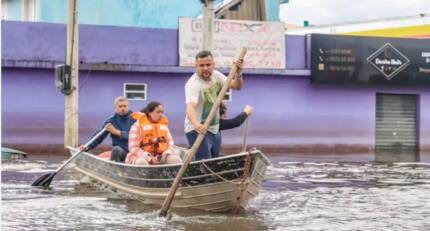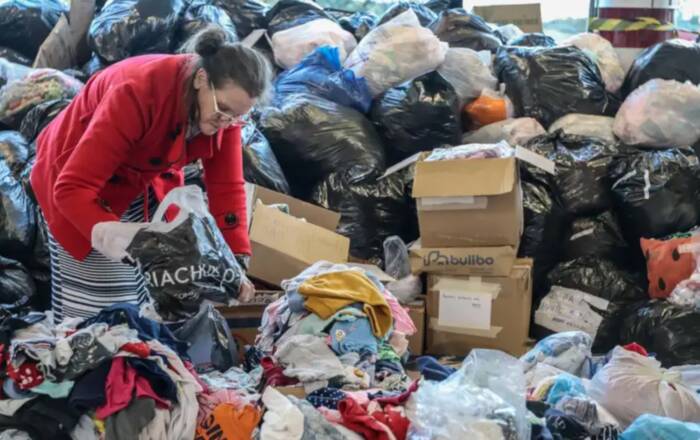
May was a month of sadness and dismay in Brazil. Extreme rainfall left two-thirds of the state of Rio Grande do Sul, which has a territory larger than that of the United Kingdom, underwater.
To date, 161 people have died and 81 are missing due to flooding caused by the unprecedented flooding of rivers and lakes in this state in southern Brazil, bordering Argentina and Uruguay. Almost 600,000 people lost their homes and more than 80,000 had to be rescued from rooftops, on boats or in security force helicopters.
Besides, more than 12,000 pets had to be saved from death by rescue teams, including a horse that was left stranded on a roof and became a symbol of the surreal impact that a tragedy like this represents.
The images and testimonies of those affected are heartbreaking. At 350.org, we also had employees and partners personally affected by the disasters. An indigenous leader who, two years ago, played a fundamental role in the fight to end a coal mine project in the region and thus helped prevent the environmental degradation of a huge area, lost her home and saw her neighborhood destroyed. A freelance colleague in the Communications area had to hurriedly leave her apartment, on the first floor of a building in the state capital, because the water level accumulated in the street rose so quickly that it reached the height of her doors and windows. Fortunately, both of our friends are safe, but the scare and damage caused to them – and the hundreds of thousands of people affected – will last a long time.
The individual effects of the tragedy are also reflected on a collective scale, and the economic impacts will be felt not just at the state level but nationally. One of the country’s main financial analysis companies, MB Associados, estimates that the disaster will reduce Brazilian GDP growth by up to 0.5 percentage points in 2024, due to the massive destruction of infrastructure and the loss of goods and services in Rio Grande do Sul. Company analysts say a climate event has never caused so much economic damage in Brazil.
And it is worth remembering that, as often happens in times of great collective loss, poor communities and families made up of black and indigenous people were disproportionately harmed. Environmental racism and climate injustice have once again become clear.
What caused such a disaster?
Such a destructive event was only possible due to a combination of several factors, including the relaxation of environmental protection legislation in the state and the lack of maintenance in river water containment structures. Not to mention long-term structural causes, such as the waterproofing of soil in cities and the lack of a housing policy that provides housing in safe areas for everyone.
Plus, a consensus among those climate experts who analysed this case is that the rains over the state were bizarrely concentrated. Cities in the region recorded a volume of rainfall up to ten times greater than the historical average for the period.
A “rapid attribution study” by ClimaMeter, that is, research carried out by scientists to identify what caused such intense rains, showed that the climate crisis worsened the precipitation that led to the deadly floods by 15%. The researchers responsible for the assessment, led by the University of Paris-Saclay, even pointed out that El Niño, a natural climate phenomenon that usually worsens rainfall in this region of Brazil, is not enough to explain the amount of rain that formed. What they are saying is that the climate crisis played a prominent role in this catastrophe.
Since the main cause of the global climate crisis is the burning of oil, gas and coal, it is therefore evident that the current destruction of Rio Grande do Sul bears the imprint of fossil fuels, as do so many other recent disasters around the world.
Can we avoid new traumas?
The trauma, lives lost, and suffering caused will never be fully repaired, and what can be rebuilt – buildings, bridges, hospitals – will take months or years to return to operating as before. Infrastructure experts predict that recovery could take ten years or more.
To get an idea of the scale of the task, the state government predicts that it will be necessary to move entire cities from the places where they were, to rebuild them in safer areas.

Woman in a center for donations to the families affected by the floods in Rio Grande do Sul, Brazil. Credit: Rafa Neddermeyer/Agência Brasil
The costs of this reconstruction are impressive. The Brazilian government has already allocated 11 billion dollars to help the state, but the economic consultancy BRCG predicts that the need for spending could easily reach around 21 billion dollars.
And since, unfortunately, it will be necessary to rebuild a large part of the state, what can we do better this time? What lessons can we learn and put into practice? From 350.org’s point of view, at least three aspects stand out:
- Rio Grande do Sul – Locally, governments urgently need to put into practice mechanisms for building public policies together with the communities affected and those potentially affected by the climate events. In short, municipal and state governments must listen to people and respect their needs when rebuilding what was destroyed. Furthermore, it will be necessary to consider that the climate crisis has established a new “normal” for the climate, full of extreme eventd, which requires serious investment in climate adaptation.
- Brazil – Nationally, the tragedy in its own territory makes it even more obvious that Brazil needs to take advantage of its temporary leadership role in the G20 (group of the 20 largest countries and economies in the world), in 2024, and host of COP30 (the conference of the UN climate committee), in 2025, to push for a more ambitious agenda for global climate. We need much stronger national emissions’ reduction targets (NDCs), as well as a concrete global commitment to financing the energy transition, with resources flowing from rich countries to poorer ones. Brazil is demanding this and has the opportunity to sew effective commitments in this regard. Additionally, it needs to show leadership, declaring the Amazon a fossil fuel exploration free area and taking seriously real energy transition measures in the country.
- Other countries – All governments need to accelerate their fair energy transition and deforestation reduction policies, especially those in rich countries, as they are most responsible for the climate crisis. For this to happen, the world needs to allocate large volumes of resources and implement effective ways for the richest to finance the transition in the poorest communities. If we direct the subsidies that currently support the fossil fuel sector towards renewable energy and tax great wealth to finance adaptation and mitigation measures for the climate crisis, this change is possible.
Ultimately, this Brazilian tragedy shows us that in times of climate crisis, extreme events are taking on a force previously unknown. It also confirms that acting to prevent the large-scale disasters that the climate crisis brings is much easier and cheaper than remedying the situation when these tragedies happen. Most importantly, we can save lives and prevent enormous suffering if we act now.
The trailer for this dystopian film was already difficult to watch. The full film will be inedible, but we still have a chance to move on to a better session.
The post Climate neglect is destroying entire cities in Brazil appeared first on 350.

 3 weeks ago
36
3 weeks ago
36


